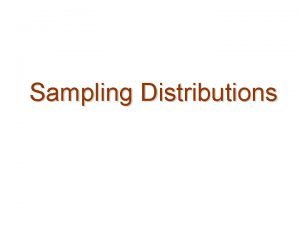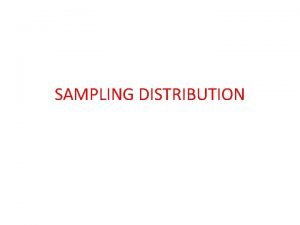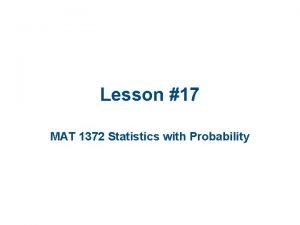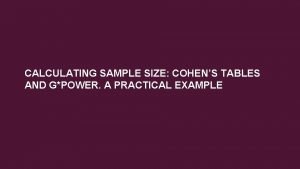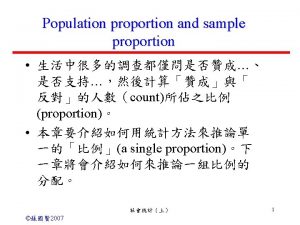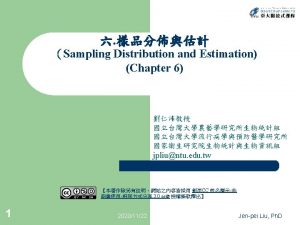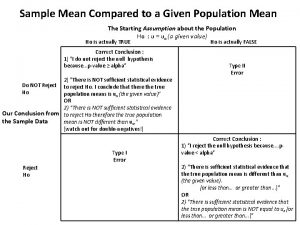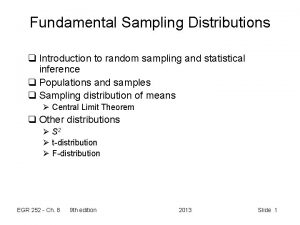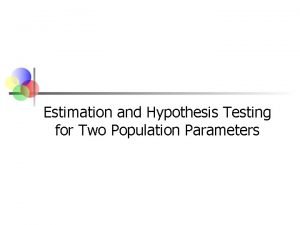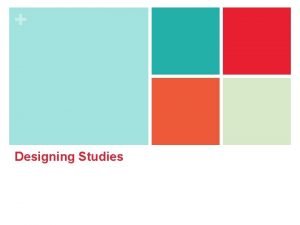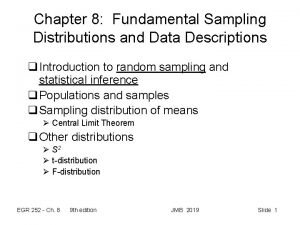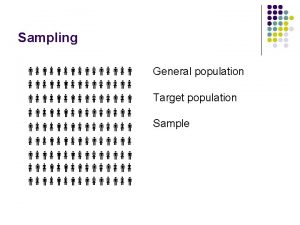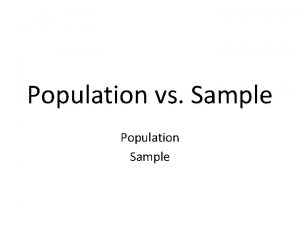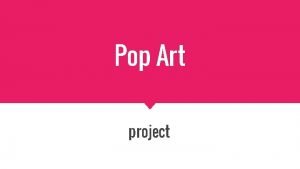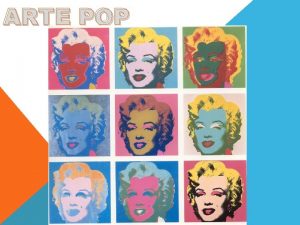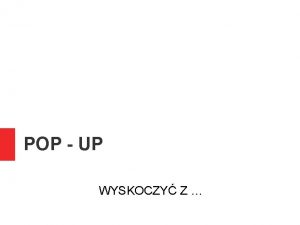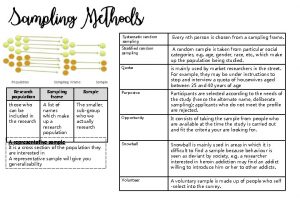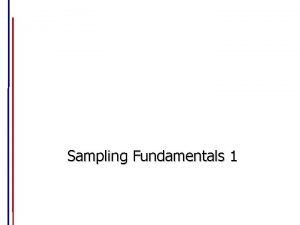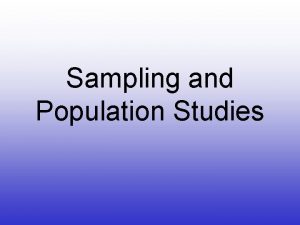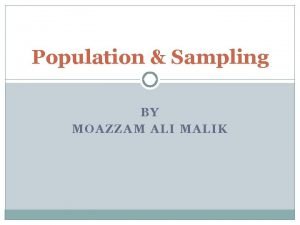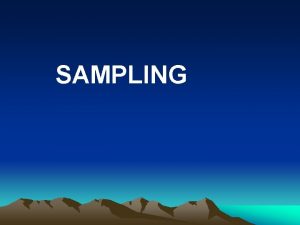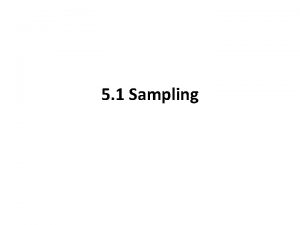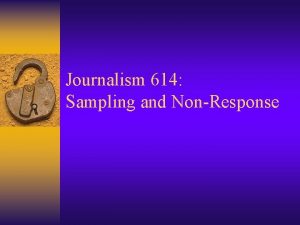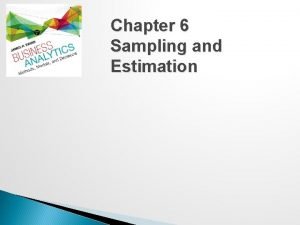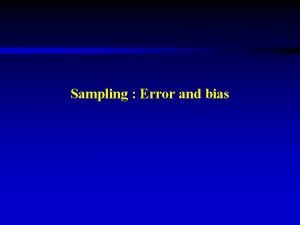Data Sampling Sample and population Population The pop






















- Slides: 22

Data Sampling

Sample and population § Population: The pop. Refers to a group of all items (individuals, objects, household etc) that have one or more characteristics in common about which the investigator wishes to draw conclusion. § Kinds of population: § 1) Homogeneous pop. 2) Heterogeneous Pop

Data Collection § Data are the basic input to any decision making process in any organization. 1) Primary 2) Secondary Data: Internal and external sources 1) internal sources: sales records, marketing activity, cost information 2) External sources : Govt. publication, journals, books, magazines, newspaper, annual and res. Report

Data Analysis § After data are collected proper tools and techniques should be used for classification and analysis of data. § Tools are: 1) Frequency distribution 2) Cumulative Frequency distribution § 3) Relative Frequency distribution 4) Charts are graphical representation of data , Bar charts, Pie charts, histogram, Frequency curve etc.

Sample: § A sample is the portion of the pop. Selected to represent the pop. or it is a sub-set of things/individuals/units taken from the pop. e. g a researcher is interested to study the weight of fishes in a pond after one month of growth. § Total fishes=2500 pop. Sample=150, students of second year from all colleges, PETUNIA plants from botanical garden.

Advantages of using a sample: § 1) Less time 2) Less cost 3) More reliable results 4) More detailed information § Sample selection must be based on following criteria, § 1) Sample size: It is the number of items to be included in the study in order to secure meaningful results. Proper smple size is v. imp. Sample should be at least 5 -10 % of the total pop. The size of the sample should be increased as the variation in the individual increased

§ The sample must always be a true representative of the whole pop. § 2) Sample selection: Types of sample. § 1) Qualitative Sample; are representing the quality of the pop. e. g. Tallness of plants, colour of fruit, smaller or bigger size of cells. § 2) Quantitative Sample: is representing the quantity, number is involved such as height of plant, total no. of fruits on a plant. Numerical meauserments are playing imp. role in drawing useful conclusion.

Limitation of Sampling: § Sample survey must be carefully planned and executed. Results eill be inaccurate. § Sampling requires the service of an expert § Major Ways of Sampling: § 1) Probability: Every item has equal chance of selection § 2) Non-probability: Every item doesn’t have an equal chance of selection i. e Quota sampling

Probability Sampling Methods: § § § 1) Simple random Sampling 2) Systematic --------3) Stratified -----------4) Cluster ---------5) Multi stage --------

1) Simple random Sampling § : For a sample to be random, it must have been selected in such a way that every element in the pop. had an equal opportunity of being included in the sample. E. g. a deck of 52 cards is thoroughly shuffled and 4 cards are drawn.

Properties: § 1) If several random samples are drawn from the same pop. the elements of the sample will differ, and therefore the statistical characteristics will change from sample to sample. § 2) Larger the , lesser will be the variation of characteristics of the sample from one random to another.

2) Systematic Sampling § This is a special kind of random sampling in which the selection of the unit of the sample from the pop. is based on randomization. The remaining units of the sample are selected from the pop. at a fixed intervals of n, where n is the sample size. § Size of pop. =N =800 N=40 Sampling interval width=N/n 800/40=20 §

3) Stratified Sampling: § The pop. is divided into groups of elements called strata such that each item in the pop. belongs to only one stratum. The strata are formed on the basis on age, height, type and so on. A simple random sample is taken from each stratum. The results depend upon the similarities among the elements within each stratum.

4) Cluster sampling: § It is sampling technique in which pop. is divided into separate groups of elements called clusters and the members within each clusterare dissimilar in terms of their attributes, but different clusters are similar to each other. A simple random sample is taken from each cluster. § In the ideal case , each cluster is a representative smallscale version of the entire pop. If the clusters are geographically subdivision, the sample is called the area sample. e. g. to study the culture of the pop. of a state and its impact on the economy, city can be divided into 9 -10 clustersthese clusters should be similar and members within each cluster are heterogenous.

§ In the ideal case , each cluster is a representative small-scale version of the entire pop. If the clusters are geographically subdivision, the sample is called the area sample. e. g. to study the culture of the pop. of a state and its impact on the economy, city can be divided into 9 -10 clustersthese clusters should be similar and members within each cluster are heterogenous.

5) Multi stage Sampling: § : In a large scale survey covering the entire nation or subcontinent, the size of the sample is too large which leads to more time and cost. In such study multistage sampling technique helps ----designing a smaller sampling frame which will make the study practicable in terms of cost and time.

§ It employs more than one stage to sample the pop. e. g. A chemical company wants to conduct the survey of requirements of lab. equipment. -in all the colleges in a country. Multi stage sampling will be used:

§ Stage 1= Different states of the country are sampled from each region----by stratified sampling. Country can be divided in different regions (strata)---north, east, west and south. States (sampling units) within each region are similar and the regions are dissimilar.

§ Stage 2= After selecting some states, one can use cluster sampling to identify districts. It is assumed that districts of a state are similar , but in the colleges are dissimilar in terms of their present lab equipment facilities. § Stage 3= In each selected districts, a random sampling is used to select the no. of colleges.

§ Study involves three stages: 1) the highest level of sampling=States § 2) Lowest level = Colleges § This sampling reduces the cost and time

Non-Probability Sampling methods § 1) Judgement 2) Convenience 3) Quota § 1) Judgement Sampling: The choice of sampling unit depends on discretion of the investigator or on the advice of some experts. e. g. 10 students is to be selected from 60 for analysis of the spending habits. § Limitations: 1) It is non scientific method 2) Involves the risk of wrong conclusion 3) There is more chance of personal biases.

§ 2) Convenience Sampling: A fraction of the pop. being investigated which is selected neither by probability nor by judgement but by convenience only. It is done in case of interview. Difficulties in interview ---nonserious, far away, non cooperate. § 3) Quota Sampling: In this, quota are set up according to some specified characteristics such as age of the pop. , several income groups. 10 -20 - 50 70%
 What does the pop in pop art stand for?
What does the pop in pop art stand for? Probability vs non probability sampling
Probability vs non probability sampling Difference between stratified and cluster sampling
Difference between stratified and cluster sampling Difference between cluster and stratified sampling ppt
Difference between cluster and stratified sampling ppt Contoh event sampling
Contoh event sampling Stratified sample vs cluster sample
Stratified sample vs cluster sample Sampling definition research
Sampling definition research Natural sampling vs flat top sampling
Natural sampling vs flat top sampling Sampling techniques for qualitative research
Sampling techniques for qualitative research Sample vs population
Sample vs population Sample proportion
Sample proportion How to solve sampling distribution of sample means
How to solve sampling distribution of sample means Sampling distribution of sample mean
Sampling distribution of sample mean Construct the sampling distribution of the sample means
Construct the sampling distribution of the sample means Cohen d effect size
Cohen d effect size Sampling distribution of the proportion
Sampling distribution of the proportion Mean of the sampling distribution of the sample mean
Mean of the sampling distribution of the sample mean Source of demographic data
Source of demographic data Sample and population difference
Sample and population difference Sample and population examples
Sample and population examples When to use upper or lower tailed test
When to use upper or lower tailed test Matched pairs design psychology
Matched pairs design psychology Example of population and sample
Example of population and sample










